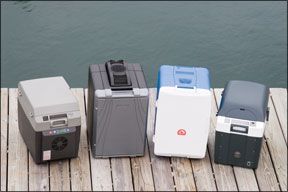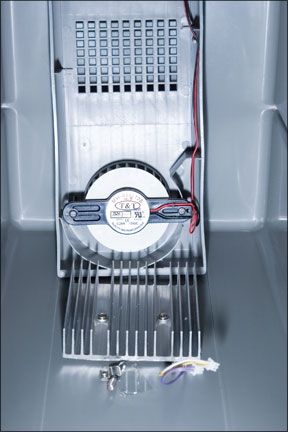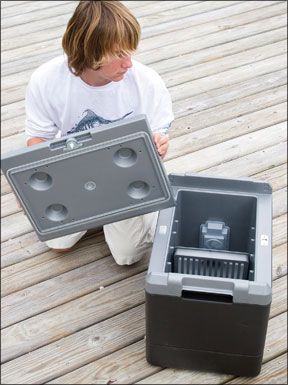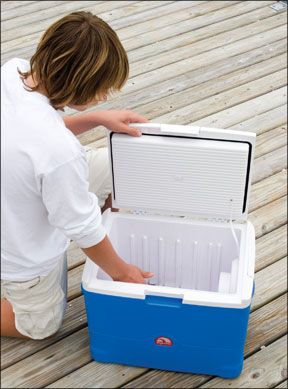The main drawback of thermoelectric coolers is power usage. This will likely be an issue during extended use or for boats with small battery banks and anemic charging systems. The 106-130 amp load, over a 24-hour period, is about twice as much demand as a built-in evaporative sytem and about three times the demand of the most efficient-and most expensive-installed systems. Also, thermoelectric units are limited in their ability to cool internal temperatures, usually to a maximum of about 40 degrees below the ambient temperature. That means these products should not be relied on to keep critical supplies cold enough when outside air temperatures are running to tropical highs. And, don’t expect to put a warm six-pack in one of these and be drinking a cold one within the hour.
***

The saying “you get what you pay for” rings true in many of our product tests. However, occasionally, the less-expensive product pulls off an upset. Such was the case in our nine-model test of portable coolers in December 2005. Two coolers from Coleman, despite their bargain price tags, came out on top-the Coleman Ultimate Extreme and the Ultimate Extreme with wheels. This month, we turn our attention once again to the challenge of keeping food and drink cold-but without the ice that is required with conventional coolers. We tested four thermoelectric coolers, including the attractively priced Coleman PowerChill. Coleman has come through again, delivering an improved product that offers the best bang for the buck.
What We Tested
Thermoelectric coolers, which we last tested for the June 1, 2003 issue, utilize a solid-state heat pump to chill interior contents. This report aims to see whether these coolers have improved in any significant way. The physics of heat transfer from the inside of the cooler to the outside remains unchanged. This phenomenon, the Peltier effect, has been known since the early 1800s. Todays thermoelectric devices use solid-state wafers, aluminum heat sinks, and electric fans to maximize the effect of heat transfer caused by passing an electric current through two connected dissimilar metals.
These types of cooling systems have several advantages and disadvantages when compared to the more common compressor-driven cooling found in modern refrigerators or freezers. Some thermoelectric advantages include small size, light weight, low cost, and quiet operation. Polarity of the power supplied to a thermoelectric device can be reversed to create a heating rather than a cooling effect.

The downsides are mostly related to inefficient cooling and high power usage. These types of cooling systems use quite a bit of electricity to produce a limited amount of cooling. Power usage for the units tested ran from 4.4 to 5.4 amps-enough current flow to draw down even a fully charged small boat battery in a day, if an alternator or onboard electronic charger is not re-supplying lost energy. Also, thermoelectric units are limited in their ability to cool internal temperatures, usually to a maximum of about 40 degrees below the ambient temperature. That means these products should not be relied on to keep critical supplies cold enough when outside air temperatures are running to tropical highs. And, don’t expect to put a warm six-pack in one of these and be drinking a cold one within the hour.
Two manufacturers, Igloo and Waeco, supplied us with test units. Igloo sent its Cool Chill 40, while Waeco sent two models: the Tropicool TC-32FL and the Mobicool CR-32. We also bought a Coleman PowerChill 40 from Wal-Mart. Prices ranged from $65 to $160.
Coleman PowerChill 40
The Kansas-based Coleman Co., a leading supplier of outdoor and camping equipment, manufacturers the 40-quart PowerChill. The cooler is designed to stand vertically like a small refrigerator or sit horizontally. We tested it in the vertical position, and found that initially, it cooled faster and to a slightly lower temperature than the others. Only the Igloo got colder, but not until after the 16-hour overnight run.

The PowerChills handles are built into the doorjambs, which are at the top and bottom of the door when the unit is in the vertical position. The door can be removed for easier loading and unloading. A self-locking plastic latch holds it shut. The interior contains one moveable shelf/divider. We had no trouble loading the provisions when the cooler was in either the vertical or horizontal position. At just under $80, the Coleman was only $14 more than the least-expensive unit tested.
Bottom Line:
The Colemans got it going on. With its leading performance, a removable door, vertical or horizontal positioning, and reasonable price, the PowerChill is the Practical Sailor Best Choice.
Igloo Cool Chill 40
The 40-quart Cool Chill performs equally well in either the vertical or horizontal positions. We tested it in the horizontal position because it looks more like a cooler than a small fridge. Overall, cooling performance was good, especially after the 16-hour overnight run, where the Igloo led the field by hitting a low temperature of 39 F. Flush, slide-out handles are located in each doorjamb. The door on the Igloo created some problems for testers while

they loaded and unloaded the groceries. It would not stay open in the vertical or horizontal positions. It always wanted to close because the plastic strap that prevents it from opening too far is not long enough, in our opinion. The door latch was simply a plastic handle that slid over a bump in the case. One moveable shelf/divider is provided. The Igloo is the most expensive cooler tested at $160. It also carries the longest warranty-two years.
Bottom Line:
A door that wont stay open and an hefty price tag hold back the Igloo Cool Chill 40.
Waeco Tropicool TC-32FL
The 34-quart Tropicool Classic is made in China and is intended to be used in the horizontal, cooler-style position. Cooling performance of the Tropicool was good; it was always within a degree or two of the better performers. You lift the unit with pivoting handles located in each side. When not in use, the handles lie flush. The top-mounted cooler lid hinges at the rear. A plastic strap secured to the lid and case keeps the lid from opening too far. An over-center lock holds the lid securely closed.
The interior has a single divider that can be placed in one of two positions. After some minor finagling, we were able to fit all of our food and drink in this cooler. The Tropicool has on/off, temperature, and hot/cold switches as well as some status-display lights to indicate

what is selected. We only operated the unit at full cold. At $124, the Tropicool is the second most expensive unit tested.
Bottom Line:
A good cooler, but the controls seem a bit too complex and gimmicky for such a simple machine. The high price tag gave us pause, too.
Waeco Mobicool CR-32
Waecos 34-quart Mobicool appears nearly identical to the more-expensive Tropicool. It too is built in China. It also appears to use the same size heat pump, is equipped with the same handles and latch, and has the same interior as the Tropicool. The two Waeco coolers performed equally. The difference we noted was the lack of multi-button control. The Tropicool uses several buttons and lights, while the Mobicool has only one toggle switch. It can be set to off/cool/heat. The Mobicool held all our food and drink, but with little room to spare. At $66, the Mobicool is the least expensive unit in our test.
Bottom Line:
Good performance, no operational flaws, and a low price earn this Waeco the Budget Buy.
Conclusions
For small-boat sailors who do not have the luxury of a full galley or a conventional refrigeration system, thermoelectric coolers will get the job done for far less money than any other alternative. Theyre more user-friendly than standard ice coolers as theres no need to lug around bags of ice. Theyre also handy in areas where ice is not cheap or readily available. The main drawback of thermoelectric coolers is power usage. This will likely be an issue during extended use or for boats with small battery banks and anemic charging systems. The 106-130 amp load, over a 24-hour period, is about twice as much demand as a built-in evaporative sytem and about three times the demand of the most efficient-and most expensive-installed systems.
We don’t think the actual performance differences among the units are significant. Instead we looked more at the total package of price, versatility, and lack of glitches.
We liked the Coleman best. Last time we tested it, editors downgraded it because it lacked a door latch. Coleman has fixed the door-latch issue and built a good cooler at a great price. For a few dollars less, you can get our Best Buy, the Waeco Mobicool CR-32, which also did well in all areas.





































Great aritcle! With marine-grade coolers, I don’t even have to own a boat to take my outdoor cooling endeavors up a notch. 🙂